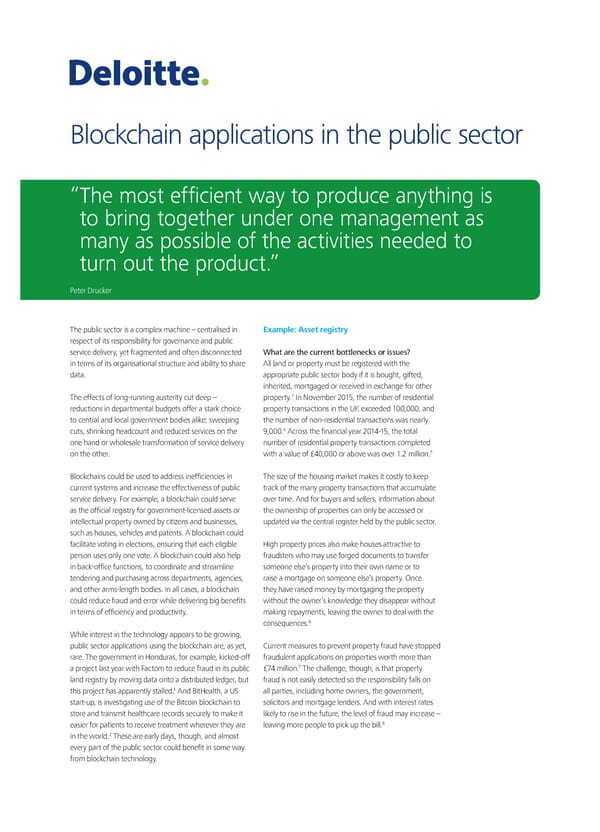To start a new section, hold down the apple+shift keys and click Document Variables to release this object and type the section title in the box below. Document Title Template Document Subtitle Subtitle Blockchain applications in the public sector “ The most efficient way to produce anything is to bring together under one management as many as possible of the activities needed to turn out the product.” Peter Drucker The public sector is a complex machine – centralised in Example: Asset registry respect of its responsibility for governance and public service delivery, yet fragmented and often disconnected What are the current bottlenecks or issues? in terms of its organisational structure and ability to share All land or property must be registered with the data. appropriate public sector body if it is bought, gifted, inherited, mortgaged or received in exchange for other 3 The effects of long-running austerity cut deep – property. In November 2015, the number of residential reductions in departmental budgets offer a stark choice property transactions in the UK exceeded 100,000, and to central and local government bodies alike: sweeping the number of non-residential transactions was nearly 4 cuts, shrinking headcount and reduced services on the 9,000. Across the financial year 2014-15, the total one hand or wholesale transformation of service delivery number of residential property transactions completed 5 on the other. with a value of £40,000 or above was over 1.2 million. Blockchains could be used to address inefficiencies in The size of the housing market makes it costly to keep current systems and increase the effectiveness of public track of the many property transactions that accumulate service delivery. For example, a blockchain could serve over time. And for buyers and sellers, information about as the official registry for government-licensed assets or the ownership of properties can only be accessed or intellectual property owned by citizens and businesses, updated via the central register held by the public sector. such as houses, vehicles and patents. A blockchain could facilitate voting in elections, ensuring that each eligible High property prices also make houses attractive to person uses only one vote. A blockchain could also help fraudsters who may use forged documents to transfer in back-office functions, to coordinate and streamline someone else’s property into their own name or to tendering and purchasing across departments, agencies, raise a mortgage on someone else’s property. Once and other arms-length bodies. In all cases, a blockchain they have raised money by mortgaging the property could reduce fraud and error while delivering big benefits without the owner’s knowledge they disappear without in terms of efficiency and productivity. making repayments, leaving the owner to deal with the 6 consequences. While interest in the technology appears to be growing, public sector applications using the blockchain are, as yet, Current measures to prevent property fraud have stopped rare. The government in Honduras, for example, kicked-off fraudulent applications on properties worth more than 7 a project last year with Factom to reduce fraud in its public £74 million. The challenge, though, is that property land registry by moving data onto a distributed ledger, but fraud is not easily detected so the responsibility falls on 1 this project has apparently stalled. And BitHealth, a US all parties, including home owners, the government, start-up, is investigating use of the Bitcoin blockchain to solicitors and mortgage lenders. And with interest rates store and transmit healthcare records securely to make it likely to rise in the future, the level of fraud may increase – 8 easier for patients to receive treatment wherever they are leaving more people to pick up the bill. 2 in the world. These are early days, though, and almost every part of the public sector could benefit in some way from blockchain technology. J3975_BlockchainInsert.indd 5 15/01/2016 17:00
 Blockchains: Enigma. Paradox. Opportunity. Page 23 Page 25
Blockchains: Enigma. Paradox. Opportunity. Page 23 Page 25